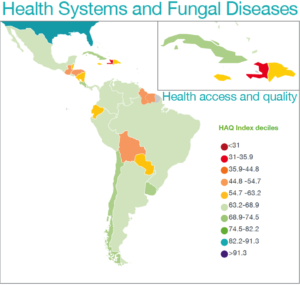
July 1st 2020 15:00 BST (GMT+1) For Spanish version click here
Briefing webinar: https://us02web.zoom.us/j/82914301088
For further details of the briefing visit ECMM website
September 3-5th over 60 fungal disease experts from Argentina, Brazil, Chile, Colombia, Costa Rica, Cuba, Dominican Republic, Ecuador, El Salvador, Guatemala, Honduras, Mexico, Nicaragua, Panama, Paraguay, Peru, Uruguay and Venezuela convened in Lima, Peru to discuss the integration of new diagnostic tools that focus on antigen and antibody detection PCR (commercial and standardized) and MALDI-TOF identification into routine care and standard fungal diagnostic procedures.
The remarkable revolution in fungal diagnostics in the past decade has moved from conventional culture and microscopy. Digital radiology now allows remote interpretation of images, allowing expertise to reach small and remote communities, if they are linked up.
The speed and sensitivity of fungal disease diagnosis is transformed by these assays but in most hospitals and clinics, very few patients are benefitting from these modern technologies. Only 9% of 129 labs in 24 countries surveyed in Latin America met the European Confederation of Medical Mycology minimum standards of test provision (Falci et al).
In collaboration with the Pan American Health Organization (PAHO) and the US Centers for Disease Control (CDC), the Global Action Fund for Fungal Infections (GAFFI) assembled experts and Ministry of Health leaders to formulate new thinking on key health system questions:
- How can these new diagnostic tools best be used?
- Which level clinic, hospital and/or reference laboratory?
- How should this data be integrated into clinical care algorithms? Fungal disease management is often complex – how do we ensure top level clinical expertise accompanies the test results, whether positive or negative?
- Non-culture tests are faster and more sensitive but don’t detect antifungal resistance. How should empiric antifungal therapy and antifungal stewardship be informed by non-culture based diagnostics
- How should these data be collected and integrated for public health surveillance?
- Who should pay for these diagnostic tests?
- How is a system of fungal disease care best coordinated? And by whom?
Dr Giovanni Ravasi, co-convener of the meeting and Advisor to HIV/STI Care and Treatment at PAHO declared:
“The mycology laboratory is fundamental to strengthening of healthcare sectors in Latin America.”
Professor David Denning, Chief Executive of GAFFI and of the University of Manchester said:
“Multiple endemic fungal diseases, the common opportunistic fungi and endemic multi-resistant Candida auris provide a toxic mix of complex fungal diseases needing a heightened public health response, which is not yet apparent in most countries in the region.”
Estimates of the incidence of key fungal diseases in 18 Latin American countries were presented :
| Disease | Incidence | Prevalence | Deaths |
| Cryptococcal meningitis | 12,300 | – | 4,900 |
| Pneumocystis pneumonia | 66,100 | – | 27,800 |
| Disseminated histoplasmosis | 9,800 | – | 5,800 |
| Invasive candidiasis | 227,300 | – | >100,000 |
| Invasive aspergillosis | 68,300 | – | >30,000 |
| Chronic pulmonary aspergillosis | 33,600 | >4,000 | |
| Fungal asthma | 1,580,000 | ? |
An outline summary of the meeting is published today online by Lancet Infectious Diseases[DD2] .
Key actions from the meeting include:
- Implementation of the WHO Essential Diagnostic list into each country for fungal infections complicating HIV infection, cancer, intensive care (including influenza), respiratory conditions such as asthma and COPD, TB-like fungal diseases and Neglected Fungal Tropical Diseases.
- Improved laboratory training utilizing a common curriculum
- With support from PAHO/WHO, CDC and the Malbran Institute in Argentina, Latin American countries will be among the 1st implementers of the Early implementation protocol for the inclusion of Candida spp in GLASS (Global Antimicrobial Resistance Surveillance), supporting countries in setting up and strengthening a national fungal AMR surveillance system, including building laboratory mycology capacity and improving data quality.
- Clinical training both for specialists and primary care, utilizing modern video-conferencing peer support approaches.
- Routine availability of antifungals on the WHO’s Essential Medicines List, especially flucytosine and liposomal amphotericin B for histoplasmosis.
- Rapid introduction of WHO guidelines for advanced HIV disease.
- Linking up hospitals with digital and teleradiology, and exploring the use of artificial intelligence Xray reading in low and middle-income countries.
- Prepare a full meeting of the report with PAHO.
Reports from the Lima meeting are found here
Resources mentioned
Garcia-Effron’s talk on Fungal Diagnostics at GAFFI Lima Meeting 2019
Burden of Serious Fungal Infections in Latin America
Integration of fungal diseases into health systems in Latin America (Lancet, July 2020)
WHO’s Essential Medicines List
Flucytosine Essential Medicines Availability
Global Fungal Infection Forum 4 in Lima